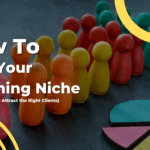Let’s talk about the one question every coach asks, whether you’re wondering how to get clients for your coaching business or looking for new strategies to scale: “How do I get people to coach?”
Not in theory. Not someday. But now, how do you get clients for your coaching business, fill your calendar, and start making money doing what you love?
If you’ve been googling things like “how to get coaching clients fast,” “how to get high-paying coaching clients,” or even “how to get clients without a website,” you’re in the right place.
Because I’ve been there. And the truth is, you don’t need a huge following, a degree in marketing, or a perfectly polished brand to start. You just need a strategy that works.
In this article, I’ll walk you through how to get more coaching clients, step by step.
We’ll cover:
- Where to show up (and why social media matters more than ever)
- What to say (even if you feel awkward selling yourself)
- And how to get coaching clients on Instagram and Facebook without burning out
Plus, I’ll share my strategies to grow my audience and how you can start seeing results, even starting from scratch. Let’s dive in.
Why Most New Coaches Struggle to Get Clients
Let’s be real: most new coaches aren’t struggling because they’re bad at coaching. They’re struggling because they’re stuck in their heads.
You tell yourself you’re not ready. You need to finish that certification. You should have more experience. You wait for the perfect time. But that moment? It never comes.
And here’s the part no one talks about: The voice that’s saying “who am I to do this?”, that’s not the truth. That’s your ego trying to protect you by keeping you exactly where you are. Safe. Comfortable. But also stuck.
I’ve been there too. And I don’t say that just to say it, I mean it.
Before I launched The Mindset Mentor Podcast, I had every fear you could imagine:
“I’m not good enough.”
“Why would anyone listen to me when they could listen to Tony Robbins?”
But deep down, something felt right. Like I had to try at least. I told myself: If it doesn’t work out, fine, but I don’t want to regret never trying.
Because the only thing worse than the pain of hard work… is the pain of regret.
So I can say for sure: what builds confidence is doing the thing while you’re still afraid.
Not when you’re ready. Not when the fear is gone. These two things can never happen, by the way. So, now.
And that separates coaches who succeed from those who stay in learning mode forever.
They don’t wait until they believe in themselves. They take action first, and the belief comes after.
So if you’ve been spinning your wheels, questioning yourself, or procrastinating your next move, that’s normal. You’re just human. But staying stuck doesn’t serve the people you’re here to help.
And no sales or marketing strategy will work if your mindset still whispers, “you’re not enough.”
So let’s flip the script: Instead of asking “Am I ready?” Ask: “Am I willing?”
Because if the answer is yes, we can help you figure out the rest.
💡 Still feel like something keeps holding you back? Listen to this episode: Why You Self-Sabotage and How to Stop. You’ll learn how to spot the traps your ego sets, and how to finally get out of your own way.
The Social Strategy: How to Get Coaching Clients Without a Website
If you’ve been telling yourself you can’t start until your website is done… let’s cut through that right now.
You don’t need a fancy homepage, ads or a full branding kit to start getting clients.
When I started, I didn’t have any of that.
What I did have was a message I believed in and a willingness to show up, consistently, on social media. That’s what built my coaching business, not a homepage.
Because one of the best ways to learn how to get coaching clients is to focus on meaningful conversations, not campaigns.
Let’s talk numbers for a second:
- As of January 2025, 246 million Americans are on social media. That’s 72.5% of the U.S. population.
- The number is still growing. Just last year, 7 million more people joined.
- The average person spends 2 hours and 8 minutes a day scrolling.
- And brands are pouring money into it. U.S. influencer ad spend is expected to hit $6.24 billion this year.
(Source: Sprinklr’s 2025 Social Media in America Report)
Translation? Your future clients are already online. They’re out there, right now, looking for hope, guidance, and transformation, and you might be the person who can help them.
So yeah, social media builds trust faster than a website ever could. It lets people hear your voice, feel your energy, and see your face. And when someone connects with you like that? They don’t care if you have a website: they just want to work with you.
So if you’re waiting for things to be “ready”…You’re playing the wrong game.
There’s more, and I say this with love: not being on social media as a coach isn’t humble, it’s selfish.
If you have a message that can help someone…
If you’ve learned something that could free someone from a pattern they’re stuck in…
Why wouldn’t you share it?
Especially in a world where the scroll is filled with fear, noise, and comparison, your voice could be the thing that cuts through all of it.
Be a creator, not just a consumer. Show up. Share what’s real. Start conversations.
Because putting good into the world matters.
And in the next two sections, I’ll show you how I did that, starting with Instagram.
How to Get Coaching Clients on Instagram
Instagram is still one of the most powerful platforms for coaches in 2025, and here’s the proof:
- 166.2 million Americans are using it.
- Over half (54.8%) are between 18–34, the exact audience most coaches are trying to reach.
- And they’re not just scrolling. The average user spends 33.1 minutes a day on the platform. If they’re 18–24? That jumps to 53 minutes.
(Source: Sprinklr’s 2025 Social Media in America Report)
That’s a lot of time and attention, which means Instagram is where your future clients are hanging out, every single day.
And if your content shows up in front of them, if it speaks directly to their struggles and goals? They’re going to stop. Watch. And connect.
Here’s the mindset shift I want you to make: Every second someone spends engaging with your content proves you’re building trust. View time isn’t just a metric, it reflects value.
But don’t overthink it. Don’t try to reinvent the wheel.
Practical tip:
Start by following 3–5 accounts in your niche that are doing what you want to be doing. Look at what you like. What feels authentic? What draws you in?
And then notice what doesn’t. What feels off or too polished? Use this as inspiration, not comparison.
And make this your first move: update your Instagram bio.
Don’t bury the lead.
Your niche — who you help and how you help them — should be front and center.
Try this formula:
My name is [Name] and I help [specific person] do [specific result].
Examples:
- “I help high-achieving women break the burnout cycle and reconnect with joy.”
- “I help divorced moms rebuild confidence and create a new chapter.”
- “I help beginner coaches get their first five clients without a website.”
Keep it real. Keep it clear. Make it easy for someone to say “That’s me.” Because when someone finds your profile and knows right away that you’re talking to them? That’s how coaching conversations start.
And when they reply to your Story or comment on your post, don’t freeze. Talk to them like a human. Start a real conversation.
Yeah, it’s that simple, and how I built my business. One post, one DM, one real connection at a time.
How to Get Coaching Clients on Facebook
Let’s set the record straight: Facebook isn’t dead. Not even close.
In fact, as of 2025, 194.1 million people in the U.S. are still actively using Facebook. That’s 68% of all U.S. adults logging in — and not just once or twice. The average user checks Facebook 8 times per day, spending over 17 hours per month on the platform. (Source: Sprinklr’s 2025 Social Media in America Report)
Why does that matter for you as a coach? Because those numbers aren’t just stats — they’re proof that your next client could be one scroll away.
And unlike Instagram, where most users are younger and still “figuring things out,” Facebook users tend to be further along in life, personally, professionally, and financially.
Roughly 1 in 4 users are aged 25–34, and many are navigating major life transitions: career shifts, divorce, parenthood, and business growth.
So, depending on your niche, Facebook is mighty if you want to attract high-paying coaching clients in life-changing moments. If your dream clients are professionals, parents, or people investing in personal development with real skin in the game, Facebook gives you reach and buying power.
And I say that with complete confidence, because I tested it myself. In one month, I gained over 200,000 new followers on Facebook. Not bots. Not fluff. Real humans who wanted support, guidance, and growth.
How? By treating Facebook like its own world, not just a repost machine.
Yes, you can share content across Instagram and Facebook. I do it too sometimes. But if you want real traction? Create content for your Facebook audience.
And most of all: test and observe. What do people resonate with? What do they ignore? Adjust as you go. That’s how I grew my audience. That’s what turns Facebook into a client-generating machine.
Maybe right now you’re thinking: “But Rob, I’m not creative enough to write content every day.” You’re not alone. I hear that all the time.
But let me be real with you: content should never be the thing holding your coaching business back. Especially not when AI tools can make it easier (without making you sound like a robot).
That’s why I created a free ChatGPT training to show you how I use it to:
✔️ Spark endless content ideas
✔️ Write faster, more connected posts
✔️ Show up consistently on Instagram and Facebook
And yes — it’s still your voice. Just faster.
👉 Click here to grab the free training
So, this is how to get coaching clients, even if you’re just starting out.
And here’s the truth most new coaches overlook: You don’t need complicated funnels or big campaigns to get clients. You just need conversations.
Real ones. The kind that happens in the DMs when someone replies to your story. The kind that happens on a free call, where you’re not pitching, you’re listening.
If you can get good at that, you can build a business. Because people don’t buy coaching… they buy clarity. And connection.
We’ll dive deeper into how to run free calls that convert, what to say in the DMs (without sounding salesy), and more tactical strategies in future posts.
Still reading? That tells me you’re ready to take this seriously.
You’ve done the inner work. You’ve got the passion, the message, maybe even a few clients.
Now it’s time to get clear, get strategic, and grow the coaching business you know you’re meant for.
That’s why I’m offering a few spots for a free 1:1 Strategy Session — just you and someone from my team, mapping out what’s next.
This isn’t a pitch. It’s a conversation. We’ll help you:
- Refine your niche and clarify your offer
- Create a plan to start (or scale) with confidence.
- Figure out how to attract clients who say: “I don’t care how much it is — I want to work with you.”
Because when you combine an aligned strategy with the courage to show up, things start to move.
👉 Click here to grab your free call, and let’s build your game plan
Frequently Asked Questions About Getting Coaching Clients
How do I get my first coaching client?
Start by getting clear on who you want to help, then show up where they are — usually Instagram or Facebook. Share real value, tell your story, and offer free clarity calls. Your first coaching client will likely come from a real conversation, not a sales pitch.
How can I get coaching clients without a website?
You don’t need a website or ads to start. Social media is your storefront, it’s where people get to know you, see your message, and decide if they want to work with you. Use your bio, posts, and DMs to create a connection. That’s how to get coaching clients without a website, and it works.
What’s the fastest way to get coaching clients?
The fastest way to get coaching clients is by starting direct conversations. Don’t wait for perfect content or funnels: talk to people. When real and service-minded, voice notes, DMs, or free calls are powerful. People want to feel seen and heard, not sold to.
How do I attract high-paying coaching clients?
You don’t need a “perfect” niche to start. Mine has changed over the years, and that’s okay. But you do need to pick one and go all in on understanding the people you want to help. Know their pain points. Speak their language. Show up consistently with value and connection. When you do that, you’ll start hearing things like: “I don’t even know how much it costs, but I want to work with you.”
Do I need a large following to get coaching clients?
Nope. I’ve seen coaches book out with under 500 followers. What matters isn’t the size of your audience, it’s the level of trust. Focus on building a real connection with a few people instead of chasing likes. If someone trusts you, they’ll hire you, even if you’re just starting.




